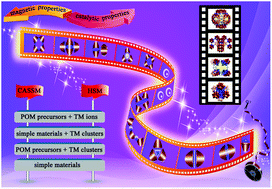The main progress over the past decade and future outlook on high-nuclear transition-metal substituted polyoxotungstates: from synthetic strategies, structural features to functional properties
Abstract
Currently, transition-metal substituted polyoxotungstates (TMSPTs) have developed as a fast growing and challengeable subfamily of polyoxoxmetalates (POMs). Before 2005, the number of TM cores in TMSPTs was mostly lower than five. Since 2005, numerous inorganic or organic–inorganic TMSPTs with more than five TM cores (denoted as high-nuclear TMSPTs) have continuously been excavated and investigated. In this perspective, we endeavor to discuss the synthetic methodologies, structural diversities and relevant properties of the high-nuclear TMSPTs reported in the past decade. Future perspectives and opportunities on TMSPTs are included in the last section. This review is meant to provide fodder and guidance for further exploration and discovery of more high-nuclear TMSPTs with innovative architectures and remarkable functionality.


 Please wait while we load your content...
Please wait while we load your content...